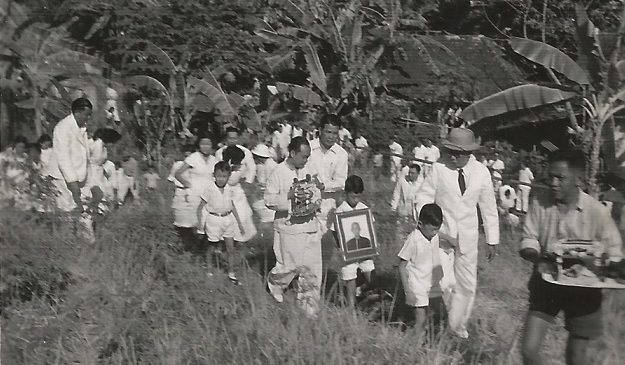Author: Dick Iskandar
19 – Funeral Rites 5/6 : Burial Rites
Funeral of Yap Tiauw Siong, Semarang, 1953
photograph courtesy of Yap Kioe Bing
Final rites were usually performed by a master of ceremony at the burial site. The position of the coffin in the grave was of utmost importance from the point of Chinese geomancy (风⽔) for the well-being of both the dead and the living. When the coffin was rightfully placed, the family of the deceased would throw earth on the coffin. Some mourners preferred to throw flowers instead
One of the rituals at the burial site was “penyebaran ngokok”. “Penyebaran” in Indonesian means “scatter”, while “ngokok” (五⾕) means “five kinds of grains” in the Hokkien dialect. The master of ceremony would throw grains at the children of the deceased who would be holding out their clothings to collect them. The collected seeds were scattered on the burial site a few days later, signifying the end of period of “heavy mourning”. This ritual was to ensure the continuation of the family line through many descendants symbolised by the many grains. “Penyebaran ngokok” is also known as “penyebaran bibit”; “bibit” in Indonesian means “seeds”.
After burial rites were over, the eldest son would fill a “hiolo” (⾹爐), or joss-stick holder with some earth from the burial site, then carried in procession together with the photograph of the deceased from the burial site. The “hiolo” would be placed on an altar for the deceased.
Christopher Ng, march 2019
This article is part number 5 of a series of 6 articles regarding Chinese Indonesian funeral rites (in the Dutch East Indies)
References:
Tan, G.L. (1963): The Chinese of Sukabumi: a study of social and cultural accommodation, New York: Monograph Series.
Wibisono, L., Northmore, M., Tjahyadi, R. And Jonathan, M. (eds) (2012): Indonesian Chinese Peranakan: a cultural journey, Jakarta: Indonesian Cross-Cultural Society and Intisari.



